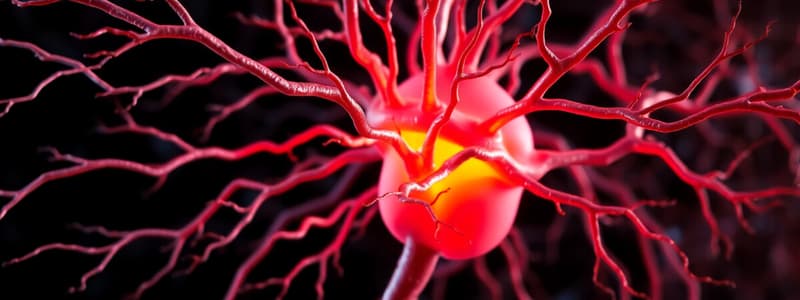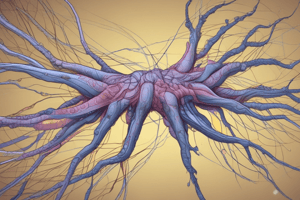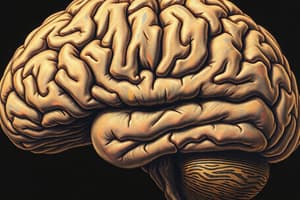Podcast
Questions and Answers
What is the function of the Circle of Willis?
What is the function of the Circle of Willis?
- Facilitates the accommodation reflex
- Transmits nerve signals to the spinal cord
- Provides blood supply to the brain structures (correct)
- Regulates blood pressure in the brain
Which cranial nerve is affected when the eye does not constrict?
Which cranial nerve is affected when the eye does not constrict?
- CN5
- CN2
- CN3 (correct)
- CN4
In the context of spinal cord tracts, which of the following is NOT a tract mentioned?
In the context of spinal cord tracts, which of the following is NOT a tract mentioned?
- Corticospinal
- Dorsal column pathway
- Lateral corticobulbar (correct)
- Spinothalamic anterior
What response does the accommodation reflex involve when shifting focus from a far object to a near object?
What response does the accommodation reflex involve when shifting focus from a far object to a near object?
Which of the following pathways is NOT involved in the autonomic nervous system functions?
Which of the following pathways is NOT involved in the autonomic nervous system functions?
What does the Bell Magendie Law explain about the spinal cord functions?
What does the Bell Magendie Law explain about the spinal cord functions?
Which of the following statements is true regarding the Dorsal Root Ganglion (DRG)?
Which of the following statements is true regarding the Dorsal Root Ganglion (DRG)?
What is the primary function of the Ventral Ramus?
What is the primary function of the Ventral Ramus?
How are spinal nerves classified based on their function?
How are spinal nerves classified based on their function?
Which area of the body is innervated by the C8 spinal nerve?
Which area of the body is innervated by the C8 spinal nerve?
Which spinal nerve is most likely to be impinged in a posterolateral herniation between L5 and S1?
Which spinal nerve is most likely to be impinged in a posterolateral herniation between L5 and S1?
Which of the following reflexes is primarily mediated by C5, with a C6 component?
Which of the following reflexes is primarily mediated by C5, with a C6 component?
What is the neurologic level for eliciting the patellar reflex?
What is the neurologic level for eliciting the patellar reflex?
Which region of the spine is more common for disc herniation?
Which region of the spine is more common for disc herniation?
What other reflex besides the biceps reflex is associated with the neurological levels C5 and C6?
What other reflex besides the biceps reflex is associated with the neurological levels C5 and C6?
Where do the spinal nerves in the lumbosacral region typically exit?
Where do the spinal nerves in the lumbosacral region typically exit?
To elicit the brachioradialis reflex, where should one tap?
To elicit the brachioradialis reflex, where should one tap?
Which reflex is commonly referred to as the 'ankle jerk' reflex?
Which reflex is commonly referred to as the 'ankle jerk' reflex?
Which spinal nerve is affected by a disc herniation between L4 and L5?
Which spinal nerve is affected by a disc herniation between L4 and L5?
What is the primary purpose of tapping a tendon during a Deep Tendon Reflex assessment?
What is the primary purpose of tapping a tendon during a Deep Tendon Reflex assessment?
Which of the following reflexes is commonly referred to as the 'Knee Jerk' reflex?
Which of the following reflexes is commonly referred to as the 'Knee Jerk' reflex?
What type of reflex is classified as monosynaptic?
What type of reflex is classified as monosynaptic?
Which muscles are assessed by the Medial Hamstrings reflex?
Which muscles are assessed by the Medial Hamstrings reflex?
What is the designation for a monosynaptic reflex involving two neurons?
What is the designation for a monosynaptic reflex involving two neurons?
During the assessment of the Lateral Hamstrings reflex, which nerve roots are primarily involved?
During the assessment of the Lateral Hamstrings reflex, which nerve roots are primarily involved?
Which reflex is involved in assessing the Tibialis Posterior?
Which reflex is involved in assessing the Tibialis Posterior?
Which myotome is responsible for managing a standard hand rim wheelchair?
Which myotome is responsible for managing a standard hand rim wheelchair?
What is a critical level for community ambulation in spinal cord injury?
What is a critical level for community ambulation in spinal cord injury?
What hip condition is required for community ambulation?
What hip condition is required for community ambulation?
Which muscle is NOT innervated by the C5 myotome?
Which muscle is NOT innervated by the C5 myotome?
Which of these is a primary requirement for stability in community ambulation?
Which of these is a primary requirement for stability in community ambulation?
What muscular function is associated with the C4 myotome?
What muscular function is associated with the C4 myotome?
Which of the following myotomes relates to neck flexion?
Which of the following myotomes relates to neck flexion?
What primary role does the suprahyoid muscle group have in cervical myotomes?
What primary role does the suprahyoid muscle group have in cervical myotomes?
Which cranial nerve is primarily responsible for mediating light and accommodation reflexes?
Which cranial nerve is primarily responsible for mediating light and accommodation reflexes?
What does anisocoria refer to in the context of eye and pupil conditions?
What does anisocoria refer to in the context of eye and pupil conditions?
Which of the following best describes the relationship between the diaphragm and cranial nerve involvement?
Which of the following best describes the relationship between the diaphragm and cranial nerve involvement?
What is indicated by an uneven eye with respect to cranial nerve function?
What is indicated by an uneven eye with respect to cranial nerve function?
Which of the following conditions may result from disrupted function of cranial nerve III?
Which of the following conditions may result from disrupted function of cranial nerve III?
Cranial nerve III is primarily responsible for which of the following functions?
Cranial nerve III is primarily responsible for which of the following functions?
What effect does cranial nerve III dysfunction have on pupil response to light?
What effect does cranial nerve III dysfunction have on pupil response to light?
Which of the following is not a function associated with cranial nerve III?
Which of the following is not a function associated with cranial nerve III?
In terms of eye accommodation, cranial nerve III plays a vital role in which process?
In terms of eye accommodation, cranial nerve III plays a vital role in which process?
An uneven pupil size could suggest an issue with which neural pathway?
An uneven pupil size could suggest an issue with which neural pathway?
Flashcards
Anisocoria
Anisocoria
Unequal pupil size in the eyes.
CN 3 (Oculomotor)
CN 3 (Oculomotor)
Cranial nerve responsible for eye movement.
Pupil
Pupil
The opening in the center of the eye that controls the amount of light entering.
Light reflex
Light reflex
Signup and view all the flashcards
Accommodation reflex
Accommodation reflex
Signup and view all the flashcards
Sympathetic
Sympathetic
Signup and view all the flashcards
Uneven eye
Uneven eye
Signup and view all the flashcards
RLA-LOCF
RLA-LOCF
Signup and view all the flashcards
CN3
CN3
Signup and view all the flashcards
Diphram
Diphram
Signup and view all the flashcards
Blood Supply to Brain (Circle of Willis)
Blood Supply to Brain (Circle of Willis)
Signup and view all the flashcards
Cranial Nerve 3
Cranial Nerve 3
Signup and view all the flashcards
Spinal Cord Tracts
Spinal Cord Tracts
Signup and view all the flashcards
Accommodation Reflex
Accommodation Reflex
Signup and view all the flashcards
Autonomic Nervous System
Autonomic Nervous System
Signup and view all the flashcards
Patellar Reflex
Patellar Reflex
Signup and view all the flashcards
Disc Herniation (L4-L5)
Disc Herniation (L4-L5)
Signup and view all the flashcards
Deep Tendon Reflex (DTR)
Deep Tendon Reflex (DTR)
Signup and view all the flashcards
Monosynaptic Reflex
Monosynaptic Reflex
Signup and view all the flashcards
Medial Hamstrings
Medial Hamstrings
Signup and view all the flashcards
Lateral Hamstrings
Lateral Hamstrings
Signup and view all the flashcards
Tibialis Posterior
Tibialis Posterior
Signup and view all the flashcards
Jaw Jerk
Jaw Jerk
Signup and view all the flashcards
Lumbar Disc Herniation
Lumbar Disc Herniation
Signup and view all the flashcards
Posterolateral Herniation
Posterolateral Herniation
Signup and view all the flashcards
Neurologic Levels of Deep Tendon Reflexes
Neurologic Levels of Deep Tendon Reflexes
Signup and view all the flashcards
Biceps Reflex
Biceps Reflex
Signup and view all the flashcards
L5-S1 spinal nerve impingement
L5-S1 spinal nerve impingement
Signup and view all the flashcards
Spinal nerve orientation
Spinal nerve orientation
Signup and view all the flashcards
Herniation Direction and Nerve Impingement
Herniation Direction and Nerve Impingement
Signup and view all the flashcards
Brachioradialis reflex
Brachioradialis reflex
Signup and view all the flashcards
Bell Magendie Law
Bell Magendie Law
Signup and view all the flashcards
Dorsal Root Ganglion (DRG)
Dorsal Root Ganglion (DRG)
Signup and view all the flashcards
Spinal Nerve (SN)
Spinal Nerve (SN)
Signup and view all the flashcards
Dorsal Ramus
Dorsal Ramus
Signup and view all the flashcards
Ventral Ramus
Ventral Ramus
Signup and view all the flashcards
Cervical Myotomes
Cervical Myotomes
Signup and view all the flashcards
C8 Myotome
C8 Myotome
Signup and view all the flashcards
Sliding Board Transfer
Sliding Board Transfer
Signup and view all the flashcards
L3 Myotome
L3 Myotome
Signup and view all the flashcards
Community Ambulation
Community Ambulation
Signup and view all the flashcards
Upper Extremity Myotomes
Upper Extremity Myotomes
Signup and view all the flashcards
Hip Flexor Strength
Hip Flexor Strength
Signup and view all the flashcards
Knee Extension
Knee Extension
Signup and view all the flashcards
Study Notes
Nervous System
- Neuronal Structures:
- Ganglion: Collection of nerve cell bodies outside the CNS
- Nucleus: Collection of nerve cell bodies inside the CNS
- Dorsal root ganglion (DRG): A type of ganglion containing sensory/afferent fibers
- Nervous System Divisions:
- Central Nervous System (CNS): Contains the brain and spinal cord
- Peripheral Nervous System (PNS): Contains nerves that extend to the body
- Somatic Nervous System (SNS): Controls voluntary muscles
- Autonomic Nervous System (ANS): Controls involuntary functions (e.g., heart rate, digestion)
- Sympathetic Nervous System: "Fight or flight" response (increase heart rate, dilate pupils, etc.)
- Parasympathetic Nervous System: "Rest and digest" response (decrease heart rate, constrict pupils, etc.)
- Cranial Nerves:
- 12 pairs of nerves originating from the brain
- Specific cranial nerves control particular functions like eye movement, swallowing, chewing etc.
- Spinal Nerves:
- 31 pairs of nerves originating from the spinal cord
- Dermatomes: Areas of skin innervated by single spinal nerves
- Myotomes: Muscles innervated by single spinal nerves
- Spinal Cord Anatomy
- Gray matter: Located inside, contains cell bodies, dendrites
- White matter: Located outisde, contains axons
- Dorsal root: Sensory (afferent) fibers
- Ventral root: Motor (efferent) fibers
- Spinal nerve: Combined dorsal and ventral roots
Neuroanatomy
- Brachial plexus: Formed from C5-T1 spinal nerves, innervates upper limb
- Lumbosacral plexus: Formed from L1-S5 spinal nerves, innervates lower limb
- Clinical correlation: Different parts of the brain have specific functions; damage can result in distinct symptoms (e.g., aphasia with damage to Broca's area)
- Blood supply to the brain: The Circle of Willis supplies blood to the brain and spinal cord
- Spinal cord injury (SCI): In SCI, the neurologic level may not always be at the same level as the vertebral injury.
Autonomic Nervous System
- Sympathetic division: Uses norepinephrine, generally increases activity
- Parasympathetic division: Uses acetylcholine, generally decreases activity.
- Two neuron pathway: Impulses from the CNS travel through two neurons before reaching the target organ
Reflexes
- Deep tendon reflexes (DTRs): Muscle stretch reflexes, assessed by tapping tendons
- Monosynaptic: One synapse between afferent and efferent neurons
- Polyysynaptic: Multiple synapses
Spinal Nerves
- Orientation: Cervical nerves generally exit above the corresponding vertebrae, while thoracic, lumbar, and sacral nerves generally exit below their corresponding vertebrae.
Other observations
- HNP (Herniated Nucleus Pulposus, Slipped Disc): Commonly seen in cervical and lumbar spine regions. Posterolateral herniations in lower back are widespread.
- Symptoms result from nerve compression
- Neurological levels of DTRs: Reflexes are helpful to assess the integrity of specific spinal nerves.
Studying That Suits You
Use AI to generate personalized quizzes and flashcards to suit your learning preferences.




